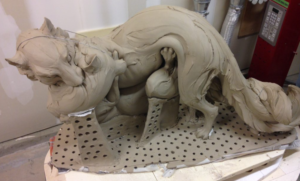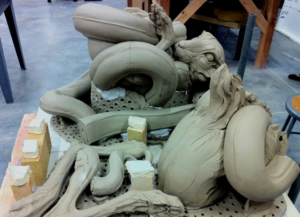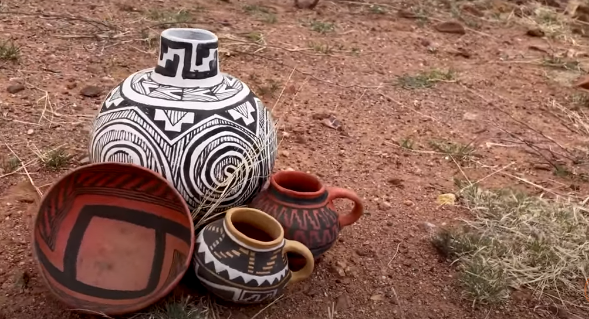Table Of Contents
- 1 Firing Clay Sculptures in a Kiln: A Comprehensive Guide to Transforming Clay into Enduring Masterpieces
- 2 The Significance of the First Stage: 200 F
- 2.1 The Crucial Transformations Occurring at 250 F
- 2.2 The Importance of Maintaining a Consistent Temperature
- 2.3 The Significance of the Cooling Phase
- 2.4 Navigating the Bisque Firing Process
- 2.5 Kiln Placement:
- 2.6 Kiln Monitoring and Control:
- 2.7 Cooling Patience:
- 2.8 Additional Tips for Successful Bisque Firing:
- 2.9 Conclusion:
- 2.10 Session 4: Embracing the Art of Clay Sculpture Firing
- 2.11 Conclusion and FAQs
- 2.12 Summary:
- 2.13 FAQs:
- 2.14 1. What is the purpose of bisque firing clay sculptures?
- 2.15 2. What is the ideal firing schedule for bisque firing earthenware clay?
- 2.16 3. How can I prevent clay sculptures from cracking during firing?
- 2.17 4. What is the importance of cooling clay sculptures slowly after firing?
- 2.18 5. What are some common mistakes to avoid during bisque firing?
Firing Clay Sculptures in a Kiln: A Comprehensive Guide to Transforming Clay into Enduring Masterpieces
In the realm of ceramics, the transformation of unfired clay into durable, long-lasting masterpieces hinges upon the crucial step of firing. Within the confines of a kiln, clay sculptures undergo a remarkable metamorphosis, shedding their delicate nature and emerging as enduring works of art. This transformative process is not merely a technical exercise; it is an artistic endeavor that demands precision, patience, and a deep understanding of the intricate interplay between heat, clay composition, and the desired aesthetic outcome.
In this comprehensive guide, we will delve into the intricacies of firing clay sculptures, exploring the essential techniques, meticulous considerations, and artistic possibilities that await ceramic enthusiasts. From understanding the fundamental processes to mastering the art of kiln operation, this guide will equip you with the knowledge and expertise to transform your clay creations into enduring masterpieces.
The Essence of Clay Sculpture Firing: Unraveling the Processes and Transformations
The firing process is a delicate dance between heat and clay, transforming the malleable nature of wet clay into a solid, durable material. As the temperature rises within the kiln, the clay undergoes a series of transformations, each playing a crucial role in imparting strength, durability, and the characteristic surface finish of a finished ceramic piece.
Water Evaporation: The initial stages of firing involve the meticulous removal of any residual water from the clay. This meticulous process is essential to prevent the expansion of water during heating, which could lead to cracking or even explosions.
Dihydroxylation: As the temperature steadily rises, the clay embarks on a journey of dihydroxylation. Hydroxyl (OH) groups are expelled from the clay’s molecular structure, leaving behind a more rigid and robust framework. This process, typically reaching around 100°C (212°F), marks the transition from leather-hard to bone-dry clay.
Vitrification: At the pinnacle of bisque firing, vitrification takes center stage. The individual clay particles, once distinct entities, fuse together, giving rise to a densely packed, glassy material. This vitrification process bestows upon the clay its characteristic strength and durability, typically occurring between 1,800-2,300°F (982-1,260°C).

The path to transforming clay sculptures into enduring masterpieces lies in meticulous adherence to the firing process. From clay preparation to kiln monitoring and cooling, each step plays a critical role in ensuring the successful firing of your ceramic creations.
Clay Preparation: Ensure that the clay sculpture is completely dry before embarking on the firing process. Excess moisture can lead to unwanted cracking or warping. Use a kiln drier or air dry the sculpture thoroughly to achieve optimal results.
Kiln Placement: Carefully position the clay piece on a kiln shelf lined with kiln paper to prevent sticking and ensure even heat distribution. Ensure that the sculpture is evenly distributed on the shelf to promote uniform heating.
Fragile Piece Support: Employ kiln posts or props to reinforce any delicate or fragile sections of the clay sculpture, preventing breakage during firing. These supports can be made from wood or metal and should be positioned strategically to provide adequate support.
Kiln Monitoring: Maintain close vigilance over the kiln throughout the firing process, ensuring that the temperature adheres to the prescribed schedule. Use a kiln sitter or controller to monitor the temperature accurately and make adjustments if necessary.
Cooling Patience: Exercise patience during the cooling phase, allowing the kiln to cool down gradually to prevent thermal shock and potential damage to the clay piece. Avoid opening the kiln door during the cooling process to minimize the risk of temperature fluctuations.
Understanding the “Fifteen Minutes at 200 F, Half Hour at 250 F” Firing Schedule
The specific firing schedule for bisque firing is tailored to the type of clay being used, the size and thickness of the piece, and the desired outcome. In general, the “fifteen minutes at 200 F, half hour at 250 F” schedule is a common and effective approach for most earthenware clays.
The Significance of the First Stage: 200 F
The initial stage at 200 F serves as a gentle preheating phase, allowing the clay to gradually acclimate to the increasing temperature and minimizing the risk of thermal shock. This initial heating also helps to evaporate any remaining water from the clay, preventing it from expanding during the subsequent firing stages, which can lead to cracking or warping.
The Crucial Transformations Occurring at 250 F
The heart of the bisque firing process unfolds at 250 F, where the clay undergoes critical transformations:
• Dihydroxylation: As the temperature reaches 250 F, the clay begins to lose water molecules, driving off hydroxyl (OH) groups from the clay’s molecular structure. This dihydroxylation process results in a more rigid and stable clay structure.
• Vitrification: Beyond the dihydroxylation phase, at around 275 F, the clay particles begin to fuse together, forming a glassy matrix. This vitrification process imparts strength, durability, and a characteristic matte surface to the bisque-fired clay.
The Importance of Maintaining a Consistent Temperature
Maintaining a consistent temperature throughout the bisque firing process is crucial for ensuring successful vitrification and the preservation of the clay’s integrity. Sudden temperature fluctuations can lead to cracking, warping, or even the disintegration of the clay piece.
The Significance of the Cooling Phase
After the bisque firing is complete, it is essential to allow the kiln to cool down gradually to prevent thermal shock. Thermal shock can occur when the kiln is cooled too quickly, causing the clay to contract rapidly, potentially leading to cracking or damage.
To achieve optimal results during bisque firing, several key considerations should be taken into account:

Clay Preparation:
-
Ensure Complete Dryness: The clay sculpture must be completely dry before embarking on the firing process. Excess moisture can lead to unwanted cracking or warping. Air dry the sculpture thoroughly or use a kiln drier to achieve optimal dryness.
-
Check for Cracks or Imperfections: Before firing, carefully inspect the clay sculpture for any cracks or imperfections. If present, these can be repaired using slip, a thin mixture of clay and water, or by smoothing out the imperfections with a damp sponge.
Kiln Placement:
-
Protect from Sticking: Place the clay piece on a kiln shelf lined with kiln paper. This prevents the clay from sticking to the shelf and ensures even heat distribution throughout the sculpture.
-
Support Fragile Sections: Reinforce any delicate or fragile sections of the clay sculpture with kiln posts or props. These props can be made from wood or metal and should be positioned strategically to provide adequate support.
Kiln Monitoring and Control:
-
Close Monitoring: Maintain close vigilance over the kiln throughout the firing process, ensuring that the temperature adheres to the prescribed schedule. Use a kiln sitter or controller to accurately monitor the temperature and make adjustments if necessary.
-
Avoid Opening the Kiln Door: Do not open the kiln door during the firing process. This can cause sudden temperature fluctuations, which can lead to cracking or damage to the clay piece.
Cooling Patience:
-
Gradual Cooling: Allow the kiln to cool down gradually to prevent thermal shock. This entails leaving the kiln closed for several hours after the firing cycle is complete.
-
Avoid Touching: Do not touch the clay piece while it is still hot. The rapid change in temperature can cause the clay to crack or warp.
Additional Tips for Successful Bisque Firing:
-
Use a Kiln that is Properly Calibrated and Maintained: A well-maintained kiln ensures consistent heat distribution and accurate temperature control, which are crucial for successful bisque firing.
-
Follow the Manufacturer’s Firing Instructions: Always consult the manufacturer’s firing instructions for the specific clay being used. These instructions provide tailored guidelines for optimal firing results.
-
Experiment with Different Firing Schedules: There is no one-size-fits-all firing schedule, so it’s beneficial to experiment with different schedules to find the one that works best for your clay and desired outcome.
Conclusion:
Bisque firing is a critical step in the ceramic process, transforming fragile clay sculptures into durable works of art. By following these guidelines and exercising patience and care, ceramic artists can achieve successful bisque firings and create ceramic masterpieces that will be treasured for years to come.
Session 4: Embracing the Art of Clay Sculpture Firing
Conclusion and FAQs
Summary:
Firing clay sculptures in a kiln is an art form in itself, requiring a delicate balance of technical expertise, artistic vision, and unwavering patience. By understanding the intricate processes that occur during firing, adhering to meticulous guidelines, and embracing the importance of each step, ceramic artists can transform their clay creations into enduring masterpieces.
As you embark on your own firing journey, remember that the path to success lies in the pursuit of knowledge, the refinement of technique, and the unwavering passion for transforming clay into art.
FAQs:
1. What is the purpose of bisque firing clay sculptures?
Bisque firing is the first stage of firing in the ceramic process and serves to harden the clay, remove any remaining moisture, and prepare it for subsequent glazing and glaze firing.
2. What is the ideal firing schedule for bisque firing earthenware clay?
A common and effective firing schedule for earthenware clay is “fifteen minutes at 200 F, half hour at 250 F”. This schedule ensures that the clay undergoes the necessary transformations while minimizing the risk of thermal shock and cracking.
3. How can I prevent clay sculptures from cracking during firing?
Several factors can contribute to cracking during firing, including:
- Excess moisture in the clay
- Rapid temperature changes
- Uneven heat distribution
- Delicate or fragile sections of the sculpture
To prevent cracking, ensure that the clay is completely dry before firing, monitor the kiln closely during the firing process, and support any fragile sections of the sculpture with kiln posts or props.
4. What is the importance of cooling clay sculptures slowly after firing?
Sudden cooling can cause thermal stress in the clay, leading to cracking or warping. Allow the kiln to cool down gradually to prevent thermal stress and preserve the integrity of the clay sculpture.
5. What are some common mistakes to avoid during bisque firing?
Some common mistakes to avoid during bisque firing include:
- Firing the clay before it is completely dry
- Opening the kiln door during the firing process
- Exposing the clay to rapid temperature fluctuations
- Failing to adequately support fragile sections of the sculpture
- Not allowing the kiln to cool down gradually
By avoiding these mistakes, ceramic artists can increase their chances of achieving successful bisque firings and creating enduring ceramic masterpieces.
